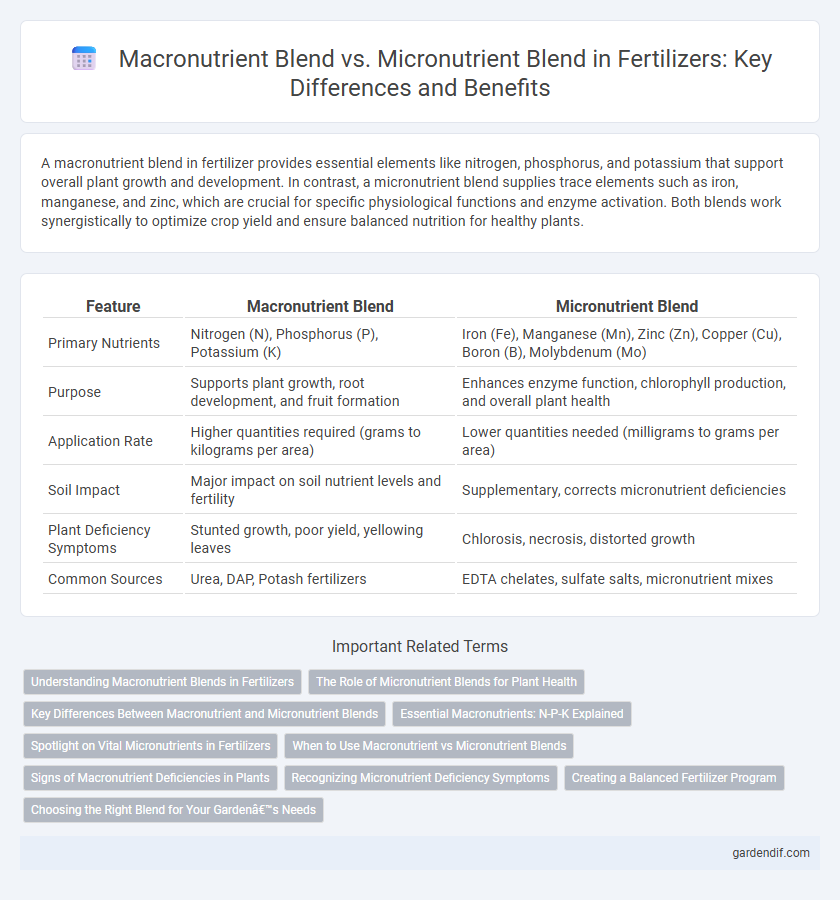
Macronutrient blend vs Micronutrient blend Illustration
A macronutrient blend in fertilizer provides essential elements like nitrogen, phosphorus, and potassium that support overall plant growth and development. In contrast, a micronutrient blend supplies trace elements such as iron, manganese, and zinc, which are crucial for specific physiological functions and enzyme activation. Both blends work synergistically to optimize crop yield and ensure balanced nutrition for healthy plants.
Table of Comparison
| Feature | Macronutrient Blend | Micronutrient Blend |
|---|---|---|
| Primary Nutrients | Nitrogen (N), Phosphorus (P), Potassium (K) | Iron (Fe), Manganese (Mn), Zinc (Zn), Copper (Cu), Boron (B), Molybdenum (Mo) |
| Purpose | Supports plant growth, root development, and fruit formation | Enhances enzyme function, chlorophyll production, and overall plant health |
| Application Rate | Higher quantities required (grams to kilograms per area) | Lower quantities needed (milligrams to grams per area) |
| Soil Impact | Major impact on soil nutrient levels and fertility | Supplementary, corrects micronutrient deficiencies |
| Plant Deficiency Symptoms | Stunted growth, poor yield, yellowing leaves | Chlorosis, necrosis, distorted growth |
| Common Sources | Urea, DAP, Potash fertilizers | EDTA chelates, sulfate salts, micronutrient mixes |
Understanding Macronutrient Blends in Fertilizers
Macronutrient blends in fertilizers primarily consist of nitrogen (N), phosphorus (P), and potassium (K), which are essential for plant growth and development. These blends are formulated to provide plants with the bulk nutrients required for photosynthesis, root development, and overall vitality. Understanding the balance and concentration of these macronutrients helps optimize crop yield and soil fertility.
The Role of Micronutrient Blends for Plant Health
Micronutrient blends provide essential elements such as iron, manganese, zinc, copper, molybdenum, and boron, critical for enzymatic functions and photosynthesis in plants. These nutrients support disease resistance, improve root development, and enhance overall plant vigor, which cannot be fulfilled by macronutrient blends alone. Balanced micronutrient application ensures optimal nutrient uptake, preventing deficiencies that can limit crop yield and quality.
Key Differences Between Macronutrient and Micronutrient Blends
Macronutrient blends primarily contain nitrogen (N), phosphorus (P), and potassium (K), essential for plant growth and development, whereas micronutrient blends include elements like iron (Fe), manganese (Mn), zinc (Zn), and copper (Cu) required in trace amounts for metabolic processes. Macronutrients influence major physiological functions such as energy transfer, cell division, and root development, while micronutrients support enzyme functions and chlorophyll synthesis. The nutrient concentration in macronutrient blends is typically measured in percentages, contrasting with parts per million (ppm) levels found in micronutrient blends, reflecting their differing roles in plant nutrition.
Essential Macronutrients: N-P-K Explained
Essential macronutrients in fertilizers primarily include nitrogen (N), phosphorus (P), and potassium (K), which are critical for plant growth, root development, and overall health. Macronutrient blends deliver these elements in balanced ratios tailored to specific crop needs, enhancing photosynthesis, energy transfer, and disease resistance. In contrast, micronutrient blends contain trace elements like zinc, iron, and manganese, necessary in smaller amounts but vital for enzyme function and metabolic processes.
Spotlight on Vital Micronutrients in Fertilizers
Vital micronutrients in fertilizers, such as iron, manganese, zinc, copper, molybdenum, and boron, play essential roles in enzyme activation, photosynthesis, and disease resistance in plants. Unlike macronutrient blends primarily composed of nitrogen, phosphorus, and potassium that support general growth, micronutrient blends target specific physiological functions critical for crop yield and quality. Ensuring balanced micronutrient availability prevents deficiencies, optimizes nutrient uptake, and enhances overall soil fertility and plant health.
When to Use Macronutrient vs Micronutrient Blends
Macronutrient blends, rich in nitrogen, phosphorus, and potassium, are essential during the active growth stages of plants to support leaf development, root establishment, and fruiting. Micronutrient blends containing elements like iron, zinc, and manganese should be applied when specific deficiencies are identified or during critical periods such as flowering and fruit set to enhance nutrient absorption and overall plant health. Correct timing of these blends optimizes crop yield and prevents nutrient imbalances that can stunt growth.
Signs of Macronutrient Deficiencies in Plants
Macronutrient deficiencies in plants often manifest as stunted growth, chlorosis, and poor fruit or seed development due to the lack of essential elements like nitrogen, phosphorus, and potassium. These symptoms differ from micronutrient deficiencies, which typically cause more specific tissue damage or discoloration without severely hindering overall plant size. Recognizing signs such as leaf yellowing, necrosis, or weak root systems helps in diagnosing macronutrient imbalances, enabling targeted fertilizer applications for optimal crop health.
Recognizing Micronutrient Deficiency Symptoms
Micronutrient deficiencies manifest through specific symptoms such as chlorosis, stunted growth, and leaf necrosis, signaling the need for targeted micronutrient blends like zinc, iron, and manganese. Macronutrient blends, consisting of nitrogen, phosphorus, and potassium, address broader plant growth requirements but may not correct subtle nutrient imbalances affecting crop health. Accurate diagnosis of micronutrient deficiencies ensures precise supplementation, enhancing nutrient uptake efficiency and optimizing overall plant development.
Creating a Balanced Fertilizer Program
A balanced fertilizer program integrates both macronutrient blends containing nitrogen, phosphorus, and potassium with micronutrient blends rich in iron, zinc, and manganese to ensure comprehensive plant nutrition. Macronutrients drive core growth processes and yield, while micronutrients support enzymatic functions and improve crop resilience. Optimizing the ratio and timing of these nutrients enhances soil health, maximizes nutrient uptake efficiency, and boosts overall crop productivity.
Choosing the Right Blend for Your Garden’s Needs
Selecting the appropriate fertilizer blend depends on your garden's nutrient requirements, with macronutrient blends providing essential nitrogen, phosphorus, and potassium to support robust plant growth and root development. Micronutrient blends supply vital trace elements like iron, manganese, and zinc, crucial for enzyme function and chlorophyll production in plants. Soil testing helps determine nutrient deficiencies, guiding gardeners to choose a fertilizer blend that optimizes plant health and maximizes crop yield.
Macronutrient blend vs Micronutrient blend Infographic

 gardendif.com
gardendif.com